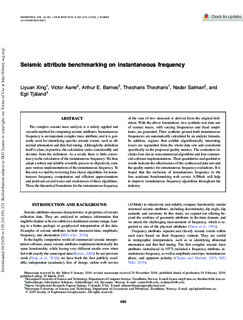| dc.contributor.author | Xing, Liyuan | |
| dc.contributor.author | Aarre, Victor | |
| dc.contributor.author | Barnes, Arthur E. | |
| dc.contributor.author | Theoharis, Theoharis | |
| dc.contributor.author | Salman, Nader | |
| dc.contributor.author | Tjåland, Egil | |
| dc.date.accessioned | 2020-01-24T11:34:21Z | |
| dc.date.available | 2020-01-24T11:34:21Z | |
| dc.date.created | 2019-11-28T12:39:44Z | |
| dc.date.issued | 2019 | |
| dc.identifier.citation | Geophysics. 2019, 84 (3), O63-O72. | nb_NO |
| dc.identifier.issn | 0016-8033 | |
| dc.identifier.uri | http://hdl.handle.net/11250/2637817 | |
| dc.description.abstract | The complex seismic trace analysis is a widely applied and versatile method for computing seismic attributes. Instantaneous frequency is an important complex trace attribute, and it is generally used for identifying specific seismic events, such as abnormal attenuation and thin bed tuning. Although the definition itself is clear, in practice, the calculation varies considerably and deviates from the definition. As a result, there is little consistency in the calculation of the instantaneous frequency. We thus adopt a robust and reliable scientific process to objectively compare various implementations of the instantaneous frequency. To this end, we start by reviewing four classic algorithms for instantaneous frequency computation and efficient approximations and point out several issues and weaknesses of these algorithms. Then, the theoretical foundation for the instantaneous frequency of the sum of two sinusoids is derived from the original definition. With the above foundations, two synthetic test data sets of seismic traces, with varying frequencies and fixed amplitudes, are generated. Their synthetic ground truth instantaneous frequencies are automatically calculated by an analytic formula. In addition, regions that exhibit algorithmically interesting issues are segmented from the whole data sets and considered specifically in the proposed quality metrics. The evaluation includes four classic noncommercial algorithms and four commercial software implementations. Their quantitative and qualitative results indicate the effectiveness of the synthesized data sets and the quality metrics for instantaneous frequency evaluations. It is hoped that the inclusion of instantaneous frequency in the free academic benchmarking web service A3Mark will help to improve instantaneous frequency algorithms throughout the industry. | nb_NO |
| dc.language.iso | eng | nb_NO |
| dc.publisher | Society of Exploration Geophysicists | nb_NO |
| dc.title | Seismic attribute benchmarking on instantaneous frequency | nb_NO |
| dc.type | Journal article | nb_NO |
| dc.type | Peer reviewed | nb_NO |
| dc.description.version | publishedVersion | nb_NO |
| dc.source.pagenumber | O63-O72 | nb_NO |
| dc.source.volume | 84 | nb_NO |
| dc.source.journal | Geophysics | nb_NO |
| dc.source.issue | 3 | nb_NO |
| dc.identifier.doi | 10.1190/geo2018-0007.1 | |
| dc.identifier.cristin | 1753730 | |
| dc.description.localcode | Use is subject to SEG terms of use and conditions. | nb_NO |
| cristin.unitcode | 194,63,10,0 | |
| cristin.unitcode | 194,64,90,0 | |
| cristin.unitname | Institutt for datateknologi og informatikk | |
| cristin.unitname | Institutt for geovitenskap og petroleum | |
| cristin.ispublished | true | |
| cristin.fulltext | postprint | |
| cristin.qualitycode | 2 | |
